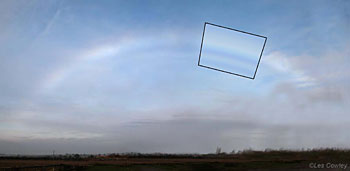Computer Simulations Shed Light on the Physics of Rainbows
By:
- Ioana Patringenaru
Published Date
By:
- Ioana Patringenaru
Share This:
Article Content

Researchers simulated a variety of rainbows. Here, their simulations, bounded by black boxes, are inserted into photographs of real rainbows.
Computer scientists at UC San Diego, who set out to simulate all rainbows found in nature, wound up answering questions about the physics of rainbows as well. The scientists recreated a wide variety of rainbows – primary rainbows, secondary rainbows, redbows that form at sunset and cloudbows that form on foggy days – by using an improved method for simulating how light interacts with water drops of various shapes and sizes. Their new approach even yielded realistic simulations of difficult-to-replicate “twinned” rainbows that split their primary bow in two.
UC San Diego alumnus Iman Sadeghi, who did the work while a Ph.D. student at the Jacobs School of Engineering, his advisor, computer science professor Henrik Wann Jensen, and scientists from Spain, England and Switzerland, will publish their findings in ACM Transactions on Graphics in December of this year.
“This goes beyond computer graphics,” Jensen said. “We now have an almost complete picture of how rainbows form.”

As a water drop falls, air pressure flattens the bottom of it and shapes it like a burger. Simulations based on the so-called burgeroids, rather than on spherical drops of water, allowed the researchers to replicate a wide range of rainbows found in nature.
Jensen is no stranger to advances in computer graphics. He earned an Academy Award in 2004 for research that brought life-like skin to animated characters. He has worked on a number of Hollywood blockbusters, including James Cameron’s “Avatar.”
Jensen, Sadeghi and colleagues originally set out to simulate rainbows to better understand how spherical water drops interact with light, resulting in the bright, multi-colored arcs that we are used to seeing when rain stops or in tropical, humid weather. They were hoping to improve techniques used in animated movies and video games.
“You usually don’t get the opportunity to study such beautiful phenomena while working on your Ph.D. thesis,” said Sadeghi, who is now a software engineer in the graphics division of Google in Santa Monica. “There is a lot more to rainbows than meets the eye.”

This is an example of a cloudbow, where small waterdrops cause the rainbow to look nearly white. Researchers simulated this by matching the size of the drops. (c) Les Cowley - Atmospheric Optics
As they started running various simulations, the scientists realized that the interaction of light with spherical drops could not explain some kinds of rainbows, such as twinned rainbows. Scientists turned to research showing that, as a water drop falls, air pressure flattens the bottom of it and shapes it like a burger. Jensen and his team called these slightly deformed water drops “burgeroids.” “It’s not a very mathematical term, but we like to use it,” Jensen said. Simulations based on the so-called burgeroids, rather than on spherical drops of water, allowed the researchers to replicate a wide range of rainbows found in nature. “We are the first to present an accurate simulation of twinned rainbows,” Sadeghi said.
The basic mechanism behind the formation of rainbows has been well understood for hundreds of years: A beam of light is both reflected and refracted within the water drop, and becomes strongly concentrated near the “rainbow angle” in the drop. The rainbow angle changes with the color of the light. As a result, sunlight separates into its spectral components, forming the colors we see in the sky. “The variation in the appearance of rainbows is due to the size and shape of rain drops” Sadeghi said.
It is surprising that the physics of rainbows are still not completely understood, Jensen said. In the past, eminent scientists, including Isaac Newton and French mathematician Rene Descartes, made calculations and conducted experiments to explain how rainbows form. But today, funding for rainbow research is scarce and so is work on the topic.
Jensen’s quest to learn about the physics of rainbows led him to the Light and Color in Nature conference at St. Mary’s College in St. Mary’s City, Md. He served as keynote speaker and met Philip Laven, an internationally renowned expert on rainbows, who became one of the study’s co-authors.

A range of simulated rainbows: From left: Rainbow based on the prevailing theory to simulate rainbows, primary rainbow with supernumerary bow, primary bow and double rainbow, primary bow with supernumerary bows and twinned rainbow, where the primary bow splits in two.
Until now, most simulations of rainbows had assumed that water drops are spherical, which isn’t true for large rain drops, Laven said. In this paper, researchers have adopted a completely different approach and developed a more realistic model to recreate rainbows, he said.
“The simulations shown in this paper offer the prospect of a better understanding of real rainbows,” Laven said. “I hope that the next step will be to use these new techniques for a systematic investigation of rainbows caused by realistically shaped rain drops.”
Jensen, Sadeghi, Laven and their colleagues plan to present their findings at the SIGGRAPH conference in 2012, which will take place in Los Angeles. Jensen also plans to attend the next Light and Color in Nature conference, which will take place in Alaska. Will he try to simulate the Northern Lights next? He just might, he said.
Share This:
You May Also Like
$10 Million Grant from Price Philanthropies Launches Behavioral Health Hub at UC San Diego Health
Health & BehaviorStay in the Know
Keep up with all the latest from UC San Diego. Subscribe to the newsletter today.



